
Nothing compares to the simple pleasure of a bike ride. J.F.Kennedy
Search this website
Taiwan, Taipei
Taipei, Taoyuan
I spent the last four days of the trip in Taipei. I arrived on a Saturday afternoon and first started to hunt for a box in which to pack my bike. There were two bike stores, but both offered rather short boxes (136 cm). I had no option but to buy a box from them (approx. $4), knowing that packing would be a challenge, as I would have to take off the racks and handlebars. But this was not such a big problem when traveling home, as I would have plenty of time to reassemble the bike. By the way, this was only the second time that I did not get a free box, but had to pay for it, even though the amount was symbolic. The first time this happened to me was in Cape Town. Next, I dealt with the issue of getting to the Airport. There was no bus or shuttle in Taipei which would pick me up with the boxes. The price of a cab to the Airport 52 km away started at 1300 TWD ($40), but it had to be arranged in advance. I could have borne it financially, but decided to cycle to the Airport instead.

Taipei: Rapid transit system operates mostly at 3-story level
Proximity to the subway (MRT Mass Rapid Transit) is an important aspect of living in Taipei. The station was 200 meters away. I bought a three-day ticket (440 TWD/ $13) and really made use of it. It was valid for unlimited travel on the subway and all city buses. The network runs underground as well as above ground to the height of three stories. The above-ground platforms are quite long and one has to take a footbridge over the rails to change trains. There are turnstiles that charge a City Card, or a single ticket – token – can be used. The price is calculated according to the distance traveled and the corresponding amount is deducted, which did not apply in my case.
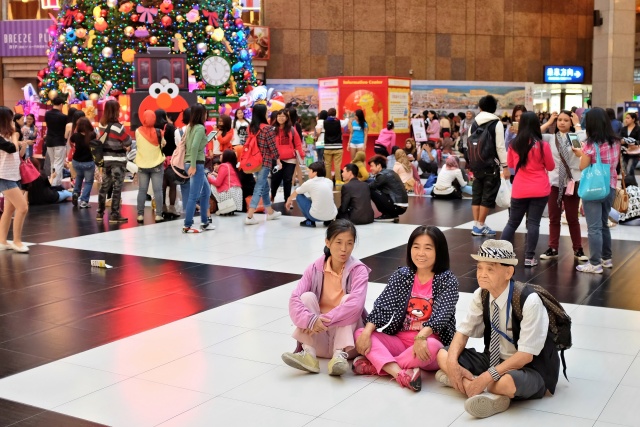
Taipei: Main Station hall (Taipei Central)
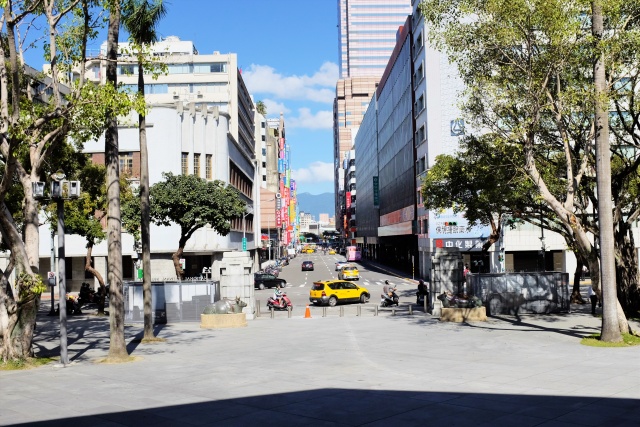
Taipei: Near National Taiwan Museum – in direction of Taipei Central station
National Taiwan Museum
I began the city exploration on a Sunday in the area around the main station — the Zhongzheng district. First I went to the National Taiwan Museum, which, with the exception of the beautiful classicist building, was not worth a visit. There was another exposition included in the price of the admission fee – in the building of the former Land Bank of Taiwan. I liked that one – I walked through a strong room with contemporary equipment, saw reconstructed skeletons of dinosaurs and their bone fragments found on the island. Then I wanted to see the presidential residence, which still serves its purpose, with guided tours organized during the daily functions. However, the Palace was surrounded by soldiers with guns and fenced off with mobile razor wire roadblocks. When I only stopped there for a short while, the soldiers whistled at me and gestured me to be on my way. Of course, there were no tours organized under those circumstances.
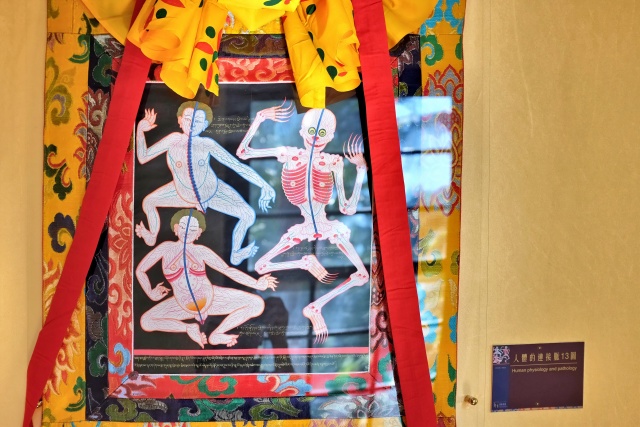
Taipei: National Taiwan Museum – exhibition of statues related to traditional Tibetan medicine
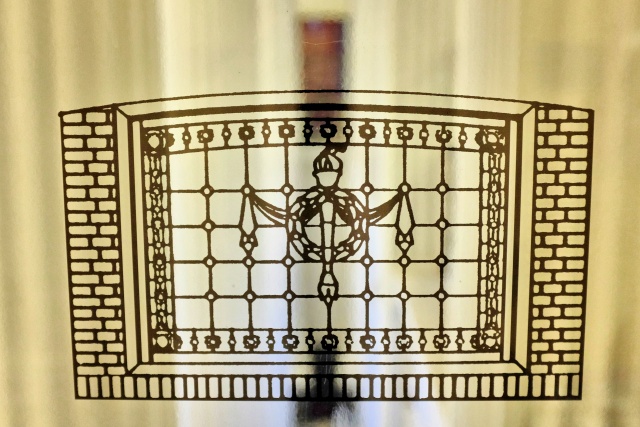
Taipei: National Taiwan Museum – detail of display case in banister filling

Taipei: Taiwan Land Bank Exhibition Hall – door to bank vault
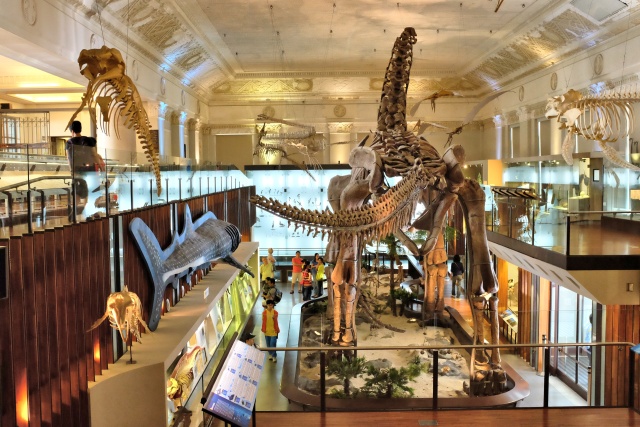
Taipei: Taiwan Land Bank Exhibition Hall – hall with dinosaur skeletons

Taipei: The Presidential Building still serves its original purpose
A short walk took me to the Chiang Kai-shek Memorial Hall. This is a group of buildings which was completed in 1980 in the traditional Chinese style. There is an impressive entrance gate, with the large Freedom Square enclosed on two sides by the National Theatre and National Concert Hall buildings. The Memorial Hall is opposite the gate.
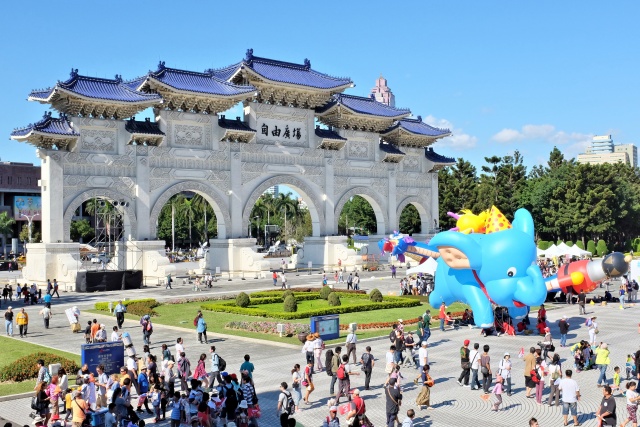
Taipei: Entrance gate on Freedom Square
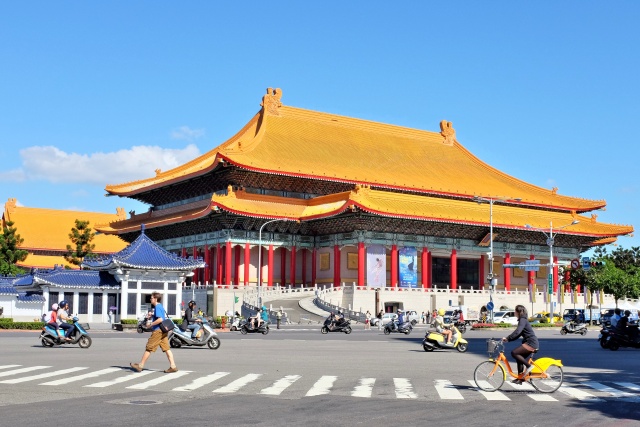
Taipei: National Theater
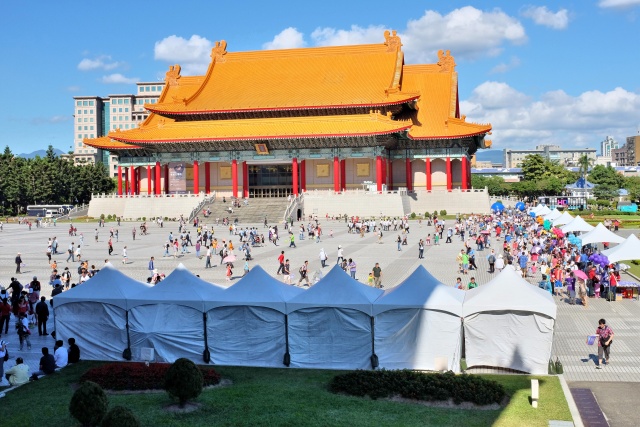
Taipei: The National Concert Hall is opposite the National Theater
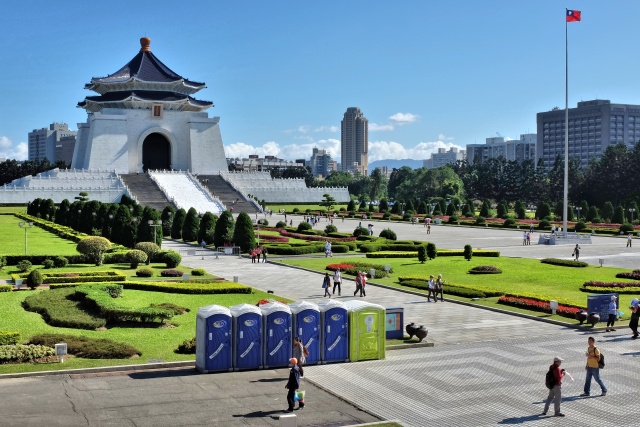
Taipei: Chiang Kai-shek Memorial at the end of Freedom Square
The square was alive, the "Hug for Taipei" festival was in full swing. People in costumes and masks, floats, music. And protesters with banners attached to their bikes.
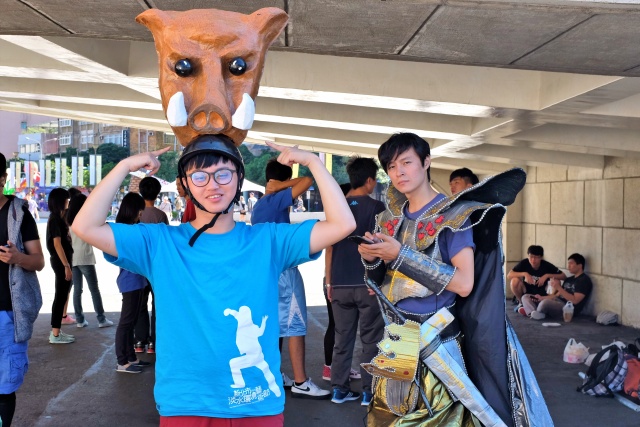
Taipei: Boys preparing for 'Hug for Taipei' parade
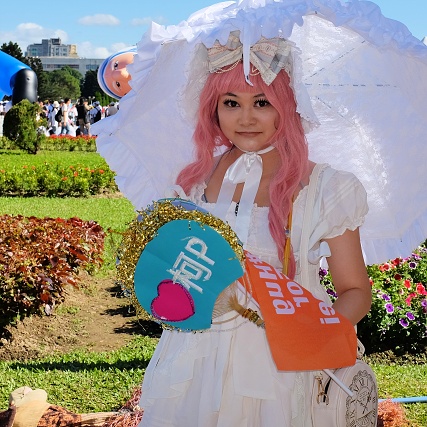
Taipei: An activist in the 'Hug for Taipei' parade, in 'Anime style' dress
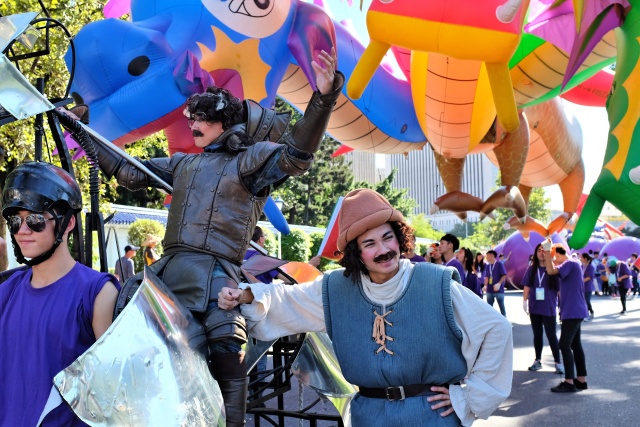
Taipei: Float

Taipei: Participants in 'Hug for Taipei' parade
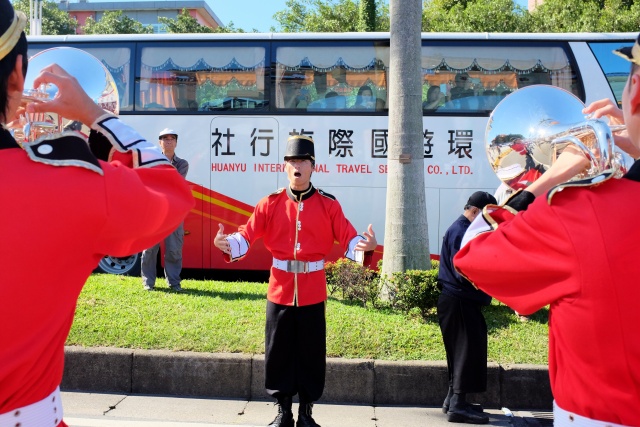
Taipei: Charismatic conductor of trumpeters

Taipei: Drummers' conductor in civilian clothes
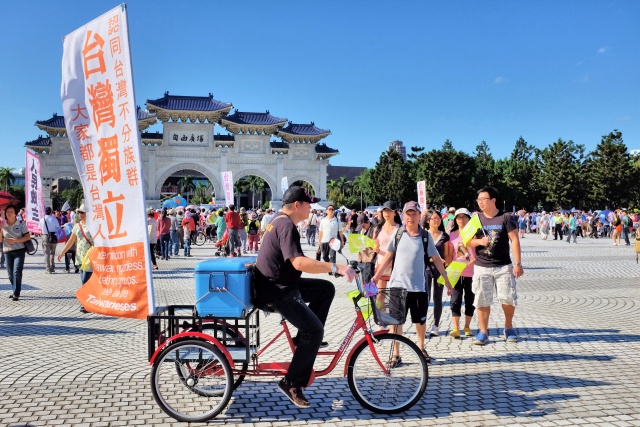
Taipei: One of the group of demonstrators with banners on bikes
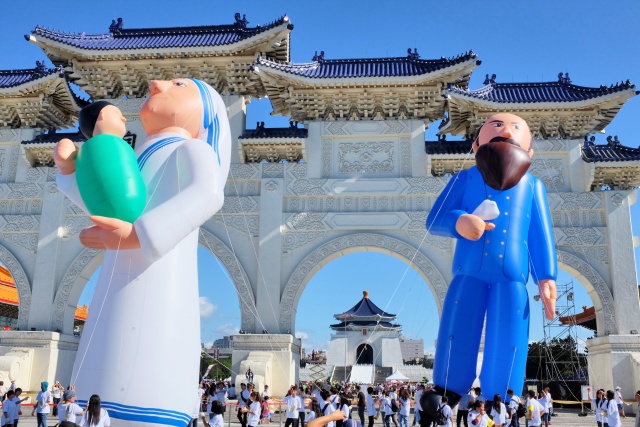
Taipei: Inflatable figures in front of Freedom Square gate
The main hall of the Chiang Kai-shek Memorial reminded me of the Lincoln Memorial in Washington, D.C. The gigantic Chiang Kai-shek is seated in an armchair resembling a throne, his hands resting on the armrests, graciously gazing down on the crowd. The guard changes every hour. The very seriously designed performance with exact choreography takes almost 15 minutes. When the changing guards were departing, I was standing so opportunely that the clenched fist of a marching soldier almost hit me on the nose.
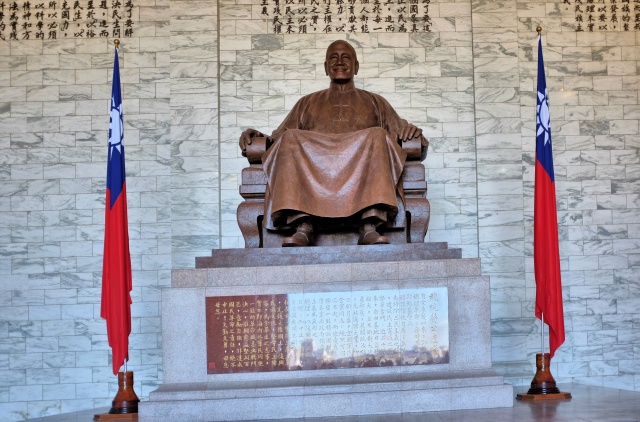
Taipei: Chiang Kai-shek Memorial – facsimile of Lincoln Memorial, Washington D.C., which I vividly remembered from the previous year
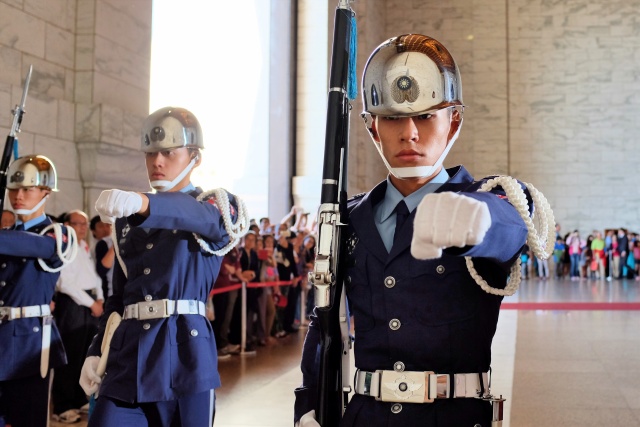
Taipei: Changing the guard in front of Chiang Kai-shek Memorial – I almost got hit, it was damn close (I don't have a zoom, just a fixed 35 mm lens)
Other sections of the Memorial displayed many photographs, documents and artifacts from the life of this certainly renowned man. I liked the two shiny Cadillacs from the time when cars were still beautiful.
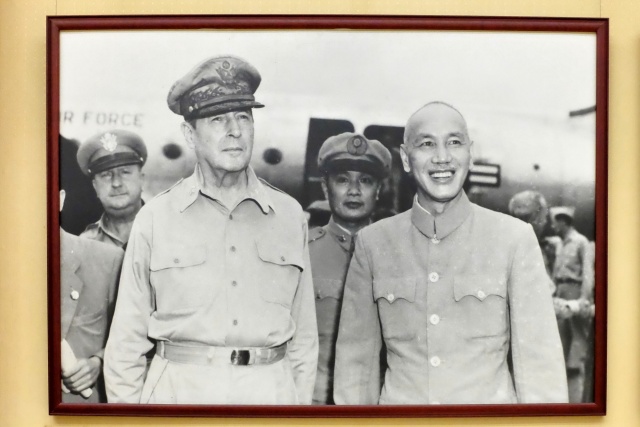
Taipei: Chiang Kai-shek with MacArthur in 1950, negotiating US military support in Korea
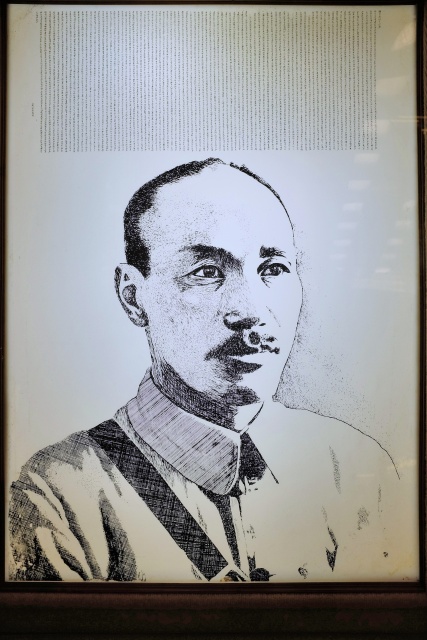
Taipei: Chiang Kai-shek’s portrait
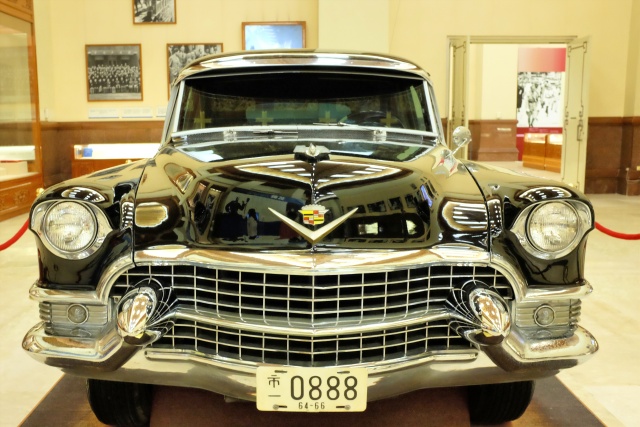
Taipei: One of Chiang Kai-shek’s two Cadillacs – beautiful car, exclusive brand
I traveled via several subway stations to Longshan Temple, where a very emotional 'worship' was being held. The place was crowded, people were really enraptured and it was fascinating. I did not want to spoil it by interrupting, so I rather left to have something to eat at the market near the Temple.

Taipei: Pond near National Theater
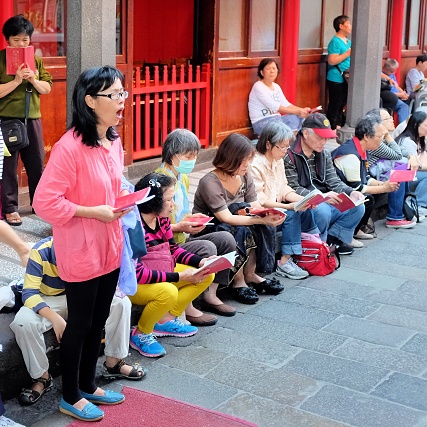
Taipei: Very emotional service in Longshan Temple
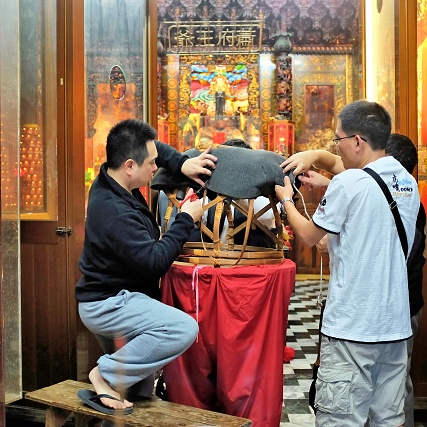
Taipei: Quinshui Temple – preparation of pedestal for statue of Mazu

Taipei: Night market in Huaxi opening shortly; goods being delivered
National Palace Museum
From now on, I will only mention the highlights. The National Palace Museum is Taipei's greatest tourist attraction. It houses one of the best collections of Chinese Art and historical artifacts. There is almost nothing there from Taiwan. These objects were brought from China to Taiwan during Chiang Kai-shek's escape from the communists in 1949. These are really the most beautiful pieces and Chiang Kai-shek actually saved them, because many objects of art were destroyed in the period of the Chinese "cultural revolution". It is forbidden to take photographs in the Museum and visitors are checked at the entrance to make sure they are not carrying cameras.
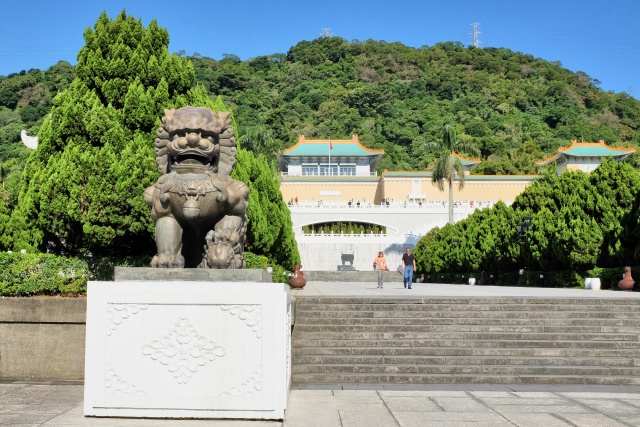
Taipei: National Palace Museum
The hordes of people were stressful — a crazy number in the morning already when I arrived. The guided excursions of Chinese tourists were the worst; they always swarmed around a certain display case and then listened to a ten-minute commentary. What a pity, there were some splendid items. I especially liked the nephrite and porcelain. It would have been nice to stop for a while to admire those, usually small, objects, but this was impossible. If one stopped, another visitor was already breathing down one's neck. There was a painting several meters long – a panoramic scene from the life of wealthy people. The animation of the figures in the painting was shown on an equally wide monitor. For example, two girls depicted in dancing poses in the painting were seen to be dancing on the monitor. I spent half a day in the Museum and would have stayed longer if conditions had been more conducive.
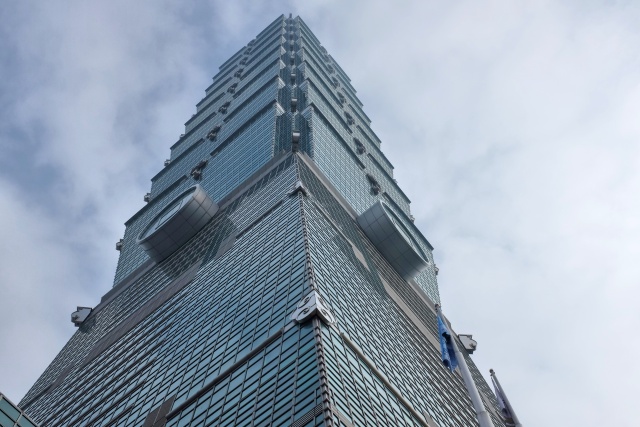
Taipei: Taipei 101 – view from below does not reflect the height of the building
Taipei 101
"Taipei 101", boasting 101 floors and a total height of 508 meters, was until recently the tallest building in the world. The observation deck on the 88th floor is open to the public and the 91st floor offers a view from the open-air gallery. There are a total 50 elevators in the tower, the speed of the one for tourists reaches 1010 meters / minute and is registered in the Guinness Book of Records as the fastest elevator for persons in the world. It took 45 seconds to reach the 88th floor, which contains the technical innovation — a 660-metric ton tuned mass damper. This prevents the "Taipei 101" from swaying during typhoons. The building was designed to resist earthquakes. What it does not resist, however, is dirt on the windows. The windows cannot be opened and washing them from the outside seems unrealistic, so I supposed that they probably used some smart window-washing system. I was wrong; the windows are washed manually from window-washing carts suspended to the exterior.
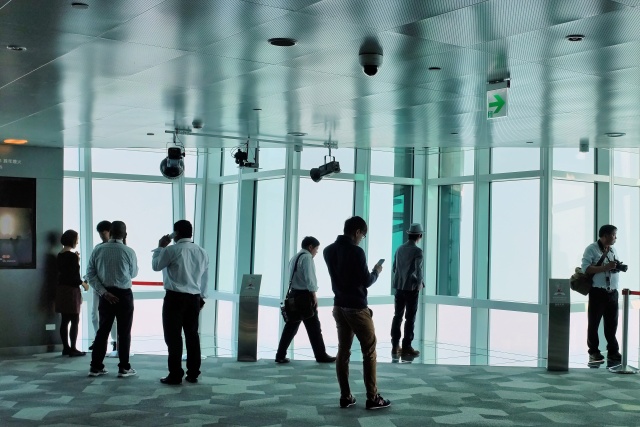
Taipei: Taipei 101 – main outlook on 88th floor
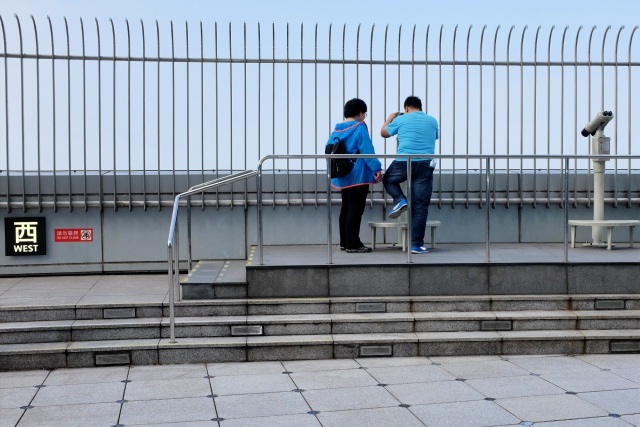
Taipei: Taipei 101 – outdoor walkway on 91st floor
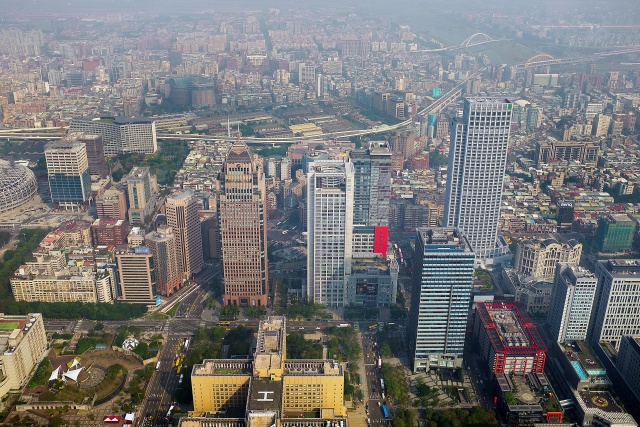
Taipei: Taipei 101 – the weather did not allow a panoramic vista, visibility was poor
Similarly to the National Palace Museum, "Taipei 101" is very popular and there were long lines for the ascent and especially for the descent. But when I visited it early in the morning, there were no lines, just a few people. Perhaps the weather was the reason for this, as it was gloomy and visibility was poor.
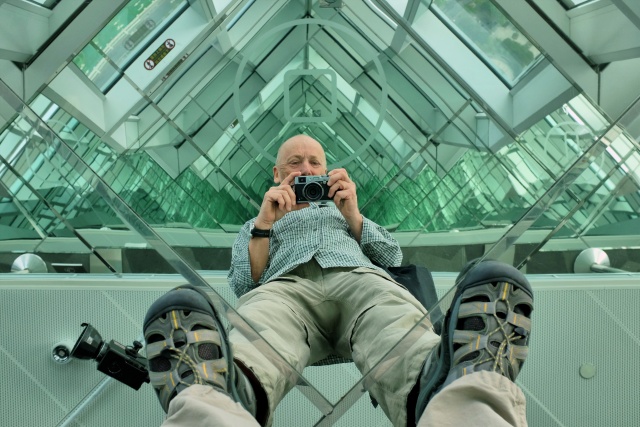
Taipei: Taipei 101 – self-portrait
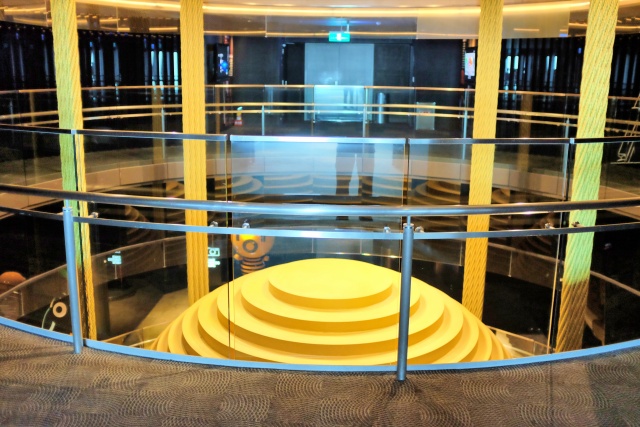
Taipei: Taipei 101 – 660-ton damper
Beitou Spa
Then I got fed up with the city. I packed my swimsuit and towel and took a subway to Beitou Spa situated in a Taipei suburb. First I bathed in hot water in the open-air hot springs. The water was very hot, even though the pool where I was bathing was supposed to contain cold water. I tried the upper level, but could not stand such hot water. I cooled myself down in the pool with colder water to have one more round. It was interesting – the heat radiating from the body warmed the water in close proximity and when I moved my hand, I felt how cold the surrounding water really was. The 40 TWD ($1.25) spa entrance fee was really affordable. Their financial balance is improved by the lockers leased for 20 TWD ($0.63), for which a visitor who is unaware of how things are done, pays twice. Which happened in my case too. I found a locker I thought was empty – there was a key sticking out of it – put in 20 TWD coins to find, after opening it, that it contained someone else’s belongings. People simply put their belongings into a locker without paying and so it was not locked. I had to check several more seemingly empty lockers, before finding one that was really empty, and paying another 20 TWD. Then I saw that many of the newly arriving bathers ended up in a similar situation.

Taipei: Beitou Spa – people using hot mineral water in the stream flowing through spa facility
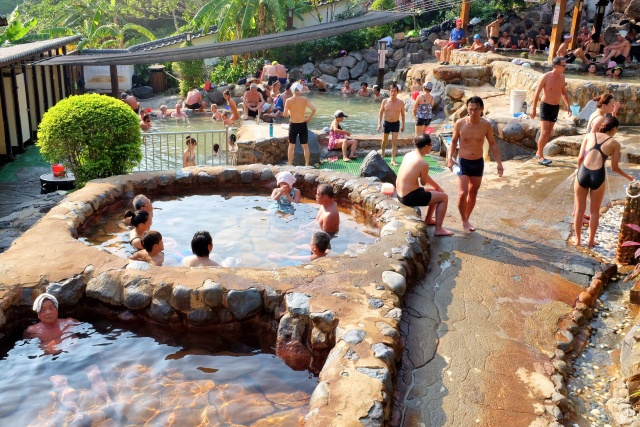
Taipei: Beitou Spa – cheapest hot mineral bath in open-air hot springs
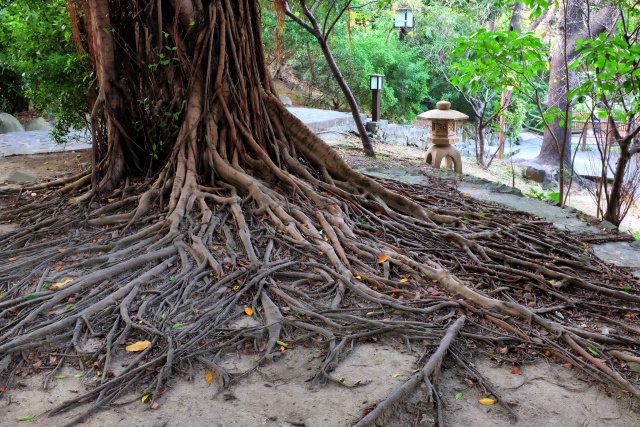
Taipei: Beitou Spa – spa park
Too much boiling spoils the fish, so I left 90 minutes later. I walked around the spa center, visited the small but charming Plum Garden and, of course, also could not miss the steaming Thermal Valley.
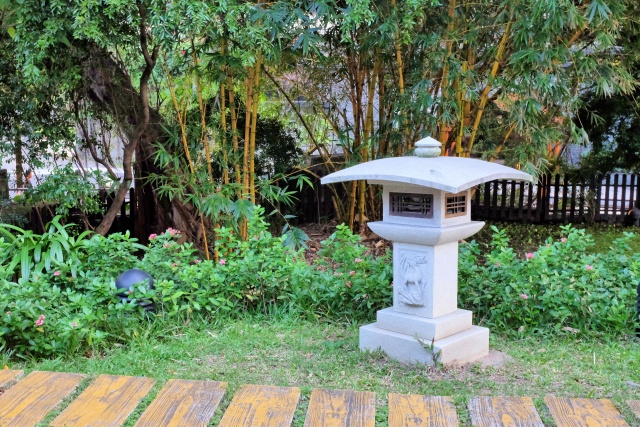
Taipei: Beitou Spa - Plum Garden
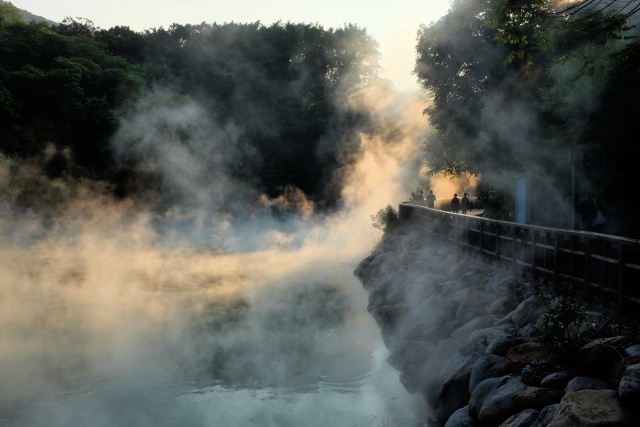
Taipei: Beitou Spa – steam in Thermal Valley was quite impressive
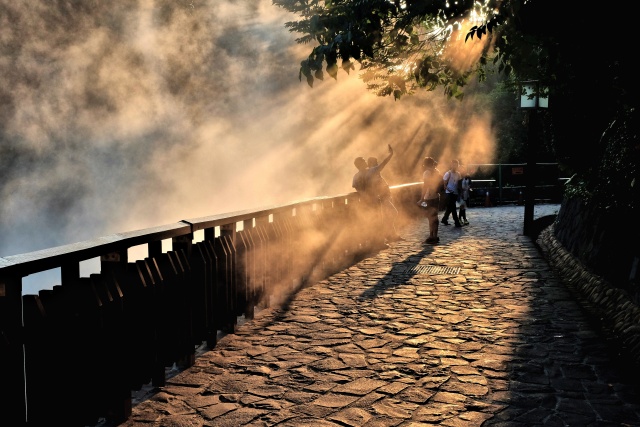
Taipei: Beitou Spa – Thermal Valley
On the return journey, I also stopped to see Baoan Temple which really excited me, especially the frescoes in the main shrine. I regretted that I had not arrived in the daylight. I tried to at least take a few photos with my pocket tripod. As I was walking back to the subway, I spotted a worker packing goods in bubble wrap in a store. I asked if he could sell me 2 meters and, with a smile, he gave me the plastic wrap free of charge.
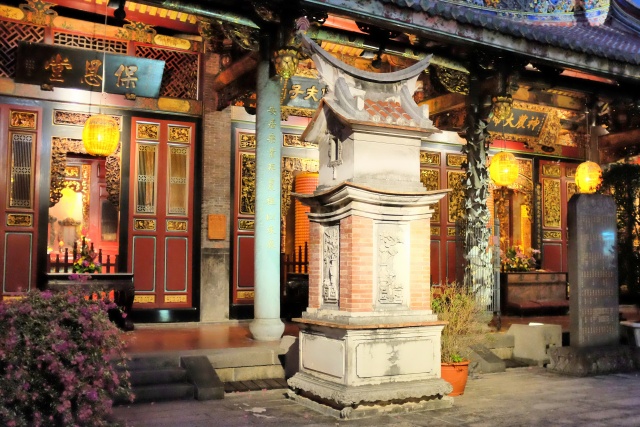
Taipei: Baoan Temple – in front of the main sanctuary
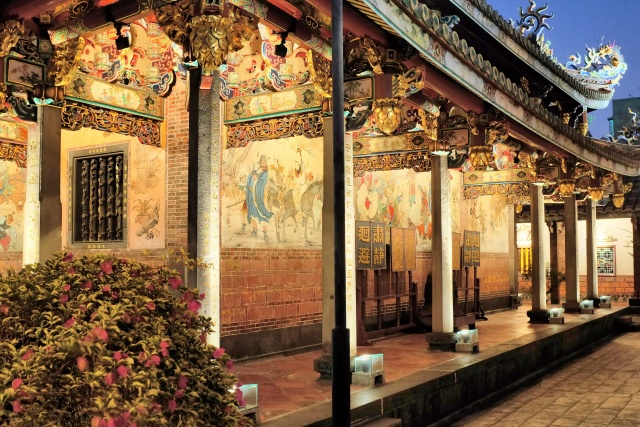
Taipei: Baoan Temple – walls are decorated with frescoes
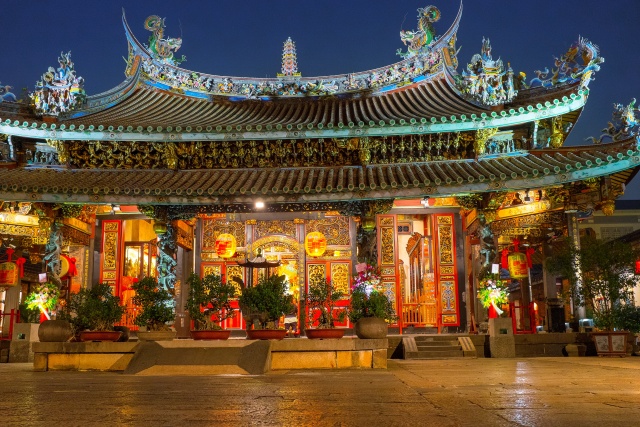
Taipei: Baoan Temple – main sanctuary
In the evening, I resumed my nightly chat with the receptionist and then began the preparations for my departure. I had a wash, then folded the boxes so that they could be attached to the bike, wrapped them in polythene in case the weather forecast was wrong and it was raining the next day (only light showers were forecast for the afternoon).
In the morning, I loaded everything on the bike and left just before 09:00. The bike was heavily laden, so I rather pushed it through the crowd of people. When the crowd thinned out, I carefully cycled on the sidewalk. I crossed the bridge. The cycling path to Bali ran on the other side. I saw the path from the bridge, but it was separated by a high antiflood wall and I could only enter it 3 km further on. Then it was easy. I dropped in on my acquaintances in Frog Café in Bali, ate the last "dog food" along the way in a 7-Eleven and at 01:00, after cycling 50 km, arrived at the Airport.
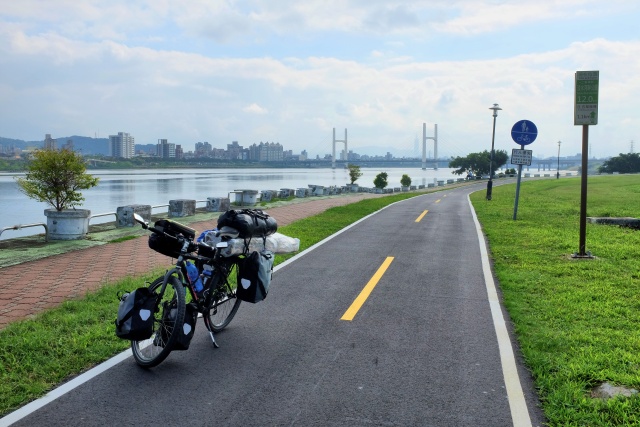
Taipei: Bike path along Tamsui River
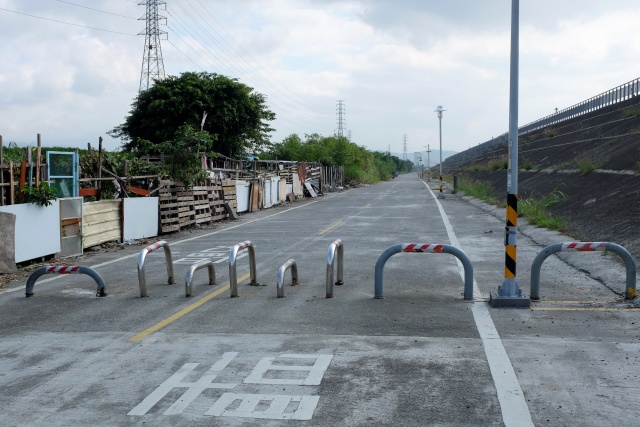
Taipei: Barriers for motorbikes were effective against bikes with bags too; I had to push the bike on the slope beside the barriers
One was not permitted to go directly to the terminals by bike or scooter. I had obeyed this on my arrival, pushing my way along the narrow pedestrian underpass, where I scraped my bags. This time, I waited for an opportune moment when nobody was around to cycle through the zone. They must have had a CCTV camera in there, as I heard an alarm sound immediately and soon was stopped by the Police. They told me that I was not allowed to cycle to the terminals. When I asked how I was supposed to get there, I was advised to take a cab. The terminal was by then only about 12 meters across the street, so I informed them that I would push my bike there and take a cab. The young policewoman was satisfied that they had reprimanded me. Her experienced partner, however, seemed rather upset. Seeing my loaded bike, he realized that I was going to the Airport and would not need a cab at all, as I would be exactly where I wanted to be by then. They preached at me some more, then stopped the traffic and let me cross the street to reach the terminal. I played with the packing for two hours and then weighed the box with the bike. My luggage weighed a total of almost 34 kg, i.e. 4 kg overweight. Moreover, I stuffed another 11 kg into the handbag and rucksack which I would carry on board with me. At the check-in, they charged me $175 for the 3 extra kilograms. Considering that the price of the return ticket Prague - Soul - Taipei - Prague was $800, that surcharge was acceptable.
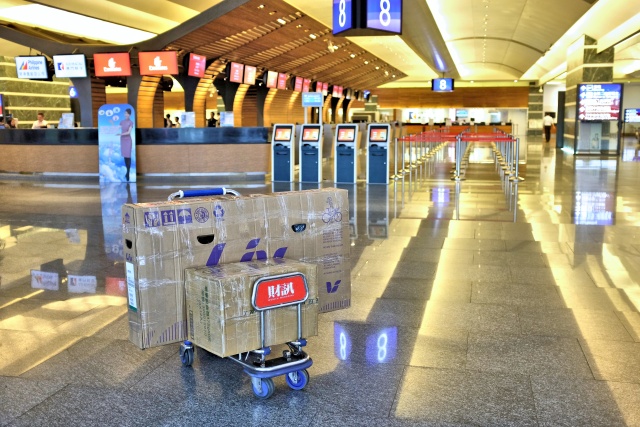
Taipei: A perfectly executed job
The Customs officers at Prague Airport were suspicious of the perfectly wrapped bike box with Chinese characters on it. I had to open it and show them the used tires to satisfy them. Of course, they did not have any adhesive tape to wrap the bike up again and prevent the contents of the box falling out into the car. However, having faced similar situations in the past, I always carry extra tape with me, so I overcame that threat too.
And that is all for this trip. I would wait to see whether my time-tested organism would be able to undertake another excursion the following year. I had no idea as yet about my next destination.

